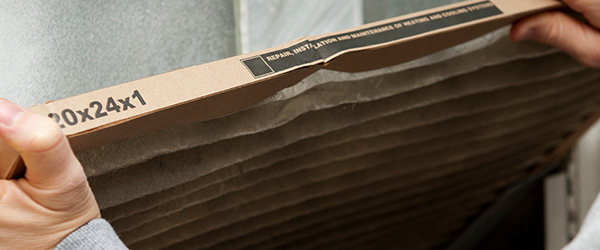When seasons change, our HVAC usage changes too. And one of the easiest ways to keep your system and your home healthy is changing your furnace filter. Easy enough, right? It sure is! Our guide gives you all you need for a successful filter change.
Why do I even need a furnace filter?
Furnace filters clean your home’s air of the dust, allergens, and toxins that make it in when we open the windows and doors, and track things in from outside.
Carpet and furniture can add to the mixture in the air, too, so considering all of the sources of dust, a filter is one of your best defenses.
Great. But why are there so many filters in the store? Which one should I buy?
You can select from a wide range of filter options based on how much you want to spend, how often you want to replace the filter, and the ability of your furnace to stay efficient:
|
Filter Type
|
Features and Benefits
|
Fiberglass Mesh
$
|
- Spun fiberglass filter within a cardboard frame, typically blue in color, comes in a variety of sizes
- Captures only the largest dirt and dust particles
- Designed to be thrown away after one or two months
|
Pleated Cotton
$$
|
- Wavy or pleated filter made from a fine cotton mesh
- Good for removing smaller dust, dirt, and pollen particles
- Run time of between four to six months
|
Pleated Anti-Allergen
$$$
|
- Pleated filter with wire support and finer filtration:
- Pulls nearly everything out of the air
- Should be replaced very regularly since they can become saturated with particulates and tax the blower
|
HEPA Filters
$$$ - $$$$
|
- Fine mesh filters available at many price points and specifically designed to trap microorganisms, yeast, and algae
- Great for anyone with allergies
- Requires frequent replacement due to capturing so many particulates
|
Enhanced Filters
$$$$
|
- Electrostatic filters designed to trap smoke and smaller airborne particles through an electrically ionized field
- Typically able to be rinsed clean as needed for reuse over several years
- Requires professional installation initially
|
Filters are also measured by a rating system called the Minimum Efficiency Reporting Values (MERV) rating. The MERV index is numbered 1 to 20, and the higher the number, the smaller the particles being captured. Most disposable filters have a MERV 3 or MERV 6 filtration.
I don’t want any particles in my air! So why would I buy a filter with a low MERV rating?
If a filter can pull out microscopic particles, then it won’t be able to let as much air pass through. You certainly want to scrub out as small a particle as possible, but this can cause the air being drawn across the filter mesh to create more force against the filter. You have to balance the strain your filter puts on your furnace, as too fine a mesh can make your
furnace lose efficiency, or worse, burn out trying to heat your home.
Replace your filters regularly to keep the furnace running smoothly and to prevent unnecessary strain on the motor.
|
I’ve got my filter picked out, but how do I know which size I need?
Check your furnace before you go to the store. The installer will usually write or post what size filter your ducting needs somewhere near the filter access. This will be three dimensions: the height, width, and thickness. The height and width are taken from the return duct size and the thickness of the filter you will need is determined by the opening cut in the duct for your filter.
The most common thickness is 1 inch; however, furnace filters can be as thick as 4 or even 8 inches. Regardless of the filter thickness, the pleating and support structure is what really matters, so keep an eye out for filters that feel sturdy and whose pleats aren’t bent or crushed.
Alright, let’s get this thing in there! What do I do?
It’s always a great idea to consult your HVAC’s manual for specific instructions, but typically, you can just pull the old filter out and slide the new filter in. Home furnace filters have a front and back. Typically, the wire mesh and paper supports are on the back of the filter. To make sure you install the filter correctly, manufacturers print an arrow on one side of the filter. Install your new filter with the arrow pointing toward the furnace.
You don’t want to have any of those used filter particles in your air, so have a plastic bag ready to put your old filter in. You can throw filters out as normal and get back to breathing easy with your new filter.
LEARN MORE ABOUT IGS HOME WARRANTY
